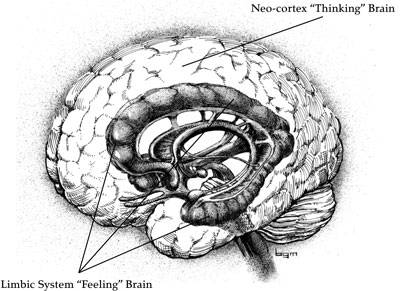Thoughts and Feelings
The first distinction we need to make is that feelings, as the word is used in this section, means emotions. The physical experiences of heat or cold or hunger are sensations - the subject of a previous section.
Secondly, feelings are not the same as thoughts, even though we commonly hear them spoken of that way. Actually, thoughts and feelings are experienced in very different areas of the brain. The limbic system, deep within the brain, is the source of emotions, while thoughts occur in the neocortex, or gray matter, which is the surface of the brain and a rather recent development in the evolution of mammals.

We respond to any given event with both thoughts and feelings. Yet most of us give priority to our thoughts about a subject and sometimes ignore the feelings. If you ask a person how he feels about a controversial political figure, and he responds by saying, I feel he should be recalled," he is really expressing an opinion (a thought), not a feeling. Recalling is not a feeling. Anger, fear, sadness, and joy are feelings. A more accurate answer, then, might be, "I feel angry with him and afraid of what he might do; I think he should be voted out of office."
Sometimes we are confused about what we are feeling. It is possible to feel both angry and sad at the same time, and one feeling may predominate only slightly over the other. It is possible to be both angry and fearful, or happy and sad about different aspects of the same situation. Also, when we are shocked by a traumatic event, the body-mind may temporarily shut down feelings that are too painful to experience all at once. In such a case, "numb" may best describe how we feel.
In most cases we have a feeling instantaneously, even though we may have learned to suppress it. Then, a fraction of a second later, the intellectual processes have time to compute, and we decide what position we will take and what we will do. This movement from feeling to thinking or from feeling to acting is described in many different ways by learning theorists and psychologists. Having some awareness of this important transition in our minds is a key wellness skill. When we know the interrelationship of feeling and thinking we can then decide what, if anything, we want to do about our feelings or our thoughts.


